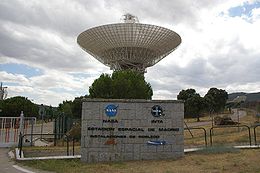
Instituto Nacional de Técnica Aeroespacial
Encyclopedia
The Instituto Nacional de Técnica Aeroespacial (INTA, National Institute of Aerospace Technology) is Spain
's space agency. It was founded in 1942, as the Instituto Nacional de Técnica Aeronáutica (National Institute of Aeronautics), and has its headquarters in Torrejón de Ardoz
, near Madrid
.
Its two main areas of activity are research and development
(for example, in propulsion, materials, remote sensing) and certification
and testing (for example, in aircraft, software, metrology).
 INTA launched its first satellite, the INTASAT, on November 15, 1974, aboard a NASA
INTA launched its first satellite, the INTASAT, on November 15, 1974, aboard a NASA
Delta rocket
. It was finally tested and attached to the rocket at INTA
headquarters facilities in Torrejon de Ardoz
, Madrid
. Next satellite in orbit was MiniSat-01, with its 190 kg it was launched on board of a Pegasus rocket
]]. over the Canary Islands in March 2002.
There was a 23 year break in the Spanish micro&nano satellite program until 1997. NanoSat-01 project was created to continue with the Spanish space program of low cost satellites. It was finally put into orbit by the Ariane 5
launch vehicle in December 2004. It was only 5 years after when Nanosat 1B . was launched on board of a Dnepr-1. Parallel to this research activity, a new research line was opened with MicroSat-1, which is a bit heavier witch just above 100 kg and its scheduled to be launched on early 2012. NanoSat-2 SeoSat (Spanish Earth Observation Satellite) are also part of the INTA R&D projects.
All these satellites are totally Spanish in manufacture and design, comprising a low-cost multiuse platform, with modular design subsystems and standard interfaces with the payload module.
Nowadays, INTA controls both the Madrid Deep Space Communication Complex
and the El Arenosillo
rocket launch site in southern Spain. From this site atmospheric sounding rocket
s are launched, such as the INTA-designed INTA-255
and INTA-300
.
Main objectives of the Nano&MicroSat programmes.
- R&D programmes in the field of small satellites from 20 kg to 150 kg started in 1997 after MiniSat-1 launch, to keep running internat space activities at INTA.
- The systems and subsystems are mainly developed at INTA with collaborations in the R&D work with several universities and other institutions in Spain
- Development of multimission Service Modules compatible with available launchers: up to 150 kg and 60x60x80cm.
- Other specific tasks or satellite units to the small business Spanish industries, to encourage their participation in space technology.
- Give flight opportunities to the Spanish research community at an affordable budget target each 3–4 years, for new experiments and instruments, in orbit demonstration technologies, earth observation and space exploration from Low Earth orbit
.
Spain
Spain , officially the Kingdom of Spain languages]] under the European Charter for Regional or Minority Languages. In each of these, Spain's official name is as follows:;;;;;;), is a country and member state of the European Union located in southwestern Europe on the Iberian Peninsula...
's space agency. It was founded in 1942, as the Instituto Nacional de Técnica Aeronáutica (National Institute of Aeronautics), and has its headquarters in Torrejón de Ardoz
Torrejón de Ardoz
Torrejón de Ardoz is a town in the urban area of Madrid, Spain that has about 110,000 inhabitants.It is a town 20 km east of Madrid on the NII highway . It is essentially a dormitory town, mostly consisting of apartments. It can be reached by bus from Av...
, near Madrid
Madrid
Madrid is the capital and largest city of Spain. The population of the city is roughly 3.3 million and the entire population of the Madrid metropolitan area is calculated to be 6.271 million. It is the third largest city in the European Union, after London and Berlin, and its metropolitan...
.
Organization
Its budget of more than €150 million comes from the Spanish Ministry of Defence and from its own projects with the industry. As of 2008 INTA has a total of 1200 employees, 80% of them dedicated to R&D activities.Its two main areas of activity are research and development
Research and development
The phrase research and development , according to the Organization for Economic Co-operation and Development, refers to "creative work undertaken on a systematic basis in order to increase the stock of knowledge, including knowledge of man, culture and society, and the use of this stock of...
(for example, in propulsion, materials, remote sensing) and certification
Certification
Certification refers to the confirmation of certain characteristics of an object, person, or organization. This confirmation is often, but not always, provided by some form of external review, education, assessment, or audit...
and testing (for example, in aircraft, software, metrology).
Operations

NASA
The National Aeronautics and Space Administration is the agency of the United States government that is responsible for the nation's civilian space program and for aeronautics and aerospace research...
Delta rocket
Delta rocket
Delta is a versatile family of expendable launch systems that has provided space launch capability in the United States since 1960. There have been more than 300 Delta rockets launched, with a 95 percent success rate. Two Delta launch systems – Delta II and Delta IV – are in active use...
. It was finally tested and attached to the rocket at INTA
INTA
INTA stands for* Committee on International Trade - a European Parliament committee* Instituto Nacional de Técnica Aeroespacial, Spanish space agency* Instituto Nacional de Tecnología Agropecuaria, National agricultural technology institute of Argentina...
headquarters facilities in Torrejon de Ardoz
Torrejón de Ardoz
Torrejón de Ardoz is a town in the urban area of Madrid, Spain that has about 110,000 inhabitants.It is a town 20 km east of Madrid on the NII highway . It is essentially a dormitory town, mostly consisting of apartments. It can be reached by bus from Av...
, Madrid
Madrid
Madrid is the capital and largest city of Spain. The population of the city is roughly 3.3 million and the entire population of the Madrid metropolitan area is calculated to be 6.271 million. It is the third largest city in the European Union, after London and Berlin, and its metropolitan...
. Next satellite in orbit was MiniSat-01, with its 190 kg it was launched on board of a Pegasus rocket
Pegasus rocket
The Pegasus rocket is a winged space launch vehicle capable of carrying small, unmanned payloads into low Earth orbit. It is air-launched, as part of an expendable launch system developed by Orbital Sciences Corporation . Three main stages burning solid propellant provide the thrust...
]]. over the Canary Islands in March 2002.
There was a 23 year break in the Spanish micro&nano satellite program until 1997. NanoSat-01 project was created to continue with the Spanish space program of low cost satellites. It was finally put into orbit by the Ariane 5
Ariane 5
Ariane 5 is, as a part of Ariane rocket family, an expendable launch system used to deliver payloads into geostationary transfer orbit or low Earth orbit . Ariane 5 rockets are manufactured under the authority of the European Space Agency and the Centre National d'Etudes Spatiales...
launch vehicle in December 2004. It was only 5 years after when Nanosat 1B . was launched on board of a Dnepr-1. Parallel to this research activity, a new research line was opened with MicroSat-1, which is a bit heavier witch just above 100 kg and its scheduled to be launched on early 2012. NanoSat-2 SeoSat (Spanish Earth Observation Satellite) are also part of the INTA R&D projects.
All these satellites are totally Spanish in manufacture and design, comprising a low-cost multiuse platform, with modular design subsystems and standard interfaces with the payload module.
Nowadays, INTA controls both the Madrid Deep Space Communication Complex
Madrid Deep Space Communication Complex
The Madrid Deep Space Communications Complex is a ground station located in Robledo de Chavela, Spain, and operated by Ingenieria y Servicios Aeroespaciales, S.A. for Instituto Nacional de Técnica Aeroespacial.-Deep Space Network:...
and the El Arenosillo
El Arenosillo
El Arenosillo is the name of a rocket launch site for suborbital rockets for atmospheric soundings, located near Mazagón in Spain. It is located in the province of Huelva in southern Spain, in the southwestern part of the autonomous community of Andalucía....
rocket launch site in southern Spain. From this site atmospheric sounding rocket
Sounding rocket
A sounding rocket, sometimes called a research rocket, is an instrument-carrying rocket designed to take measurements and perform scientific experiments during its sub-orbital flight. The origin of the term comes from nautical vocabulary, where to sound is to throw a weighted line from a ship into...
s are launched, such as the INTA-designed INTA-255
INTA-255
The INTA-255 was a Spanish sounding rocket.The INTA-255 was launched with 4 Chick rockets, which start with 0.2 seconds long burned. The INTA-255 was started three times 1969/70. The ceiling of the INTA-255 amounted to 150 km, the takeoff thrust 42.00 kN, the star mass 340 kg, the...
and INTA-300
INTA-300
The INTA-300 was a two-stage Spanish sounding rocket. It consisted of a launch stage from the type Heron and an upper stage of the type Snipe. The INTA-300 was launched six times between 1974 and 1994. The maximum flight height of INTA-300 was 250 km, a takeoff thrust of 138,00 kN, a...
.
Main objectives of the Nano&MicroSat programmes.
- R&D programmes in the field of small satellites from 20 kg to 150 kg started in 1997 after MiniSat-1 launch, to keep running internat space activities at INTA.
- The systems and subsystems are mainly developed at INTA with collaborations in the R&D work with several universities and other institutions in Spain
- Development of multimission Service Modules compatible with available launchers: up to 150 kg and 60x60x80cm.
- Other specific tasks or satellite units to the small business Spanish industries, to encourage their participation in space technology.
- Give flight opportunities to the Spanish research community at an affordable budget target each 3–4 years, for new experiments and instruments, in orbit demonstration technologies, earth observation and space exploration from Low Earth orbit
Low Earth orbit
A low Earth orbit is generally defined as an orbit within the locus extending from the Earth’s surface up to an altitude of 2,000 km...
.

